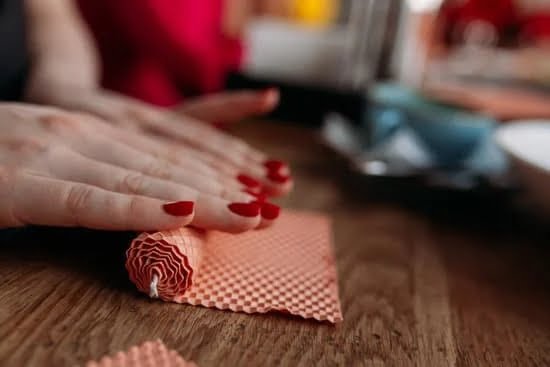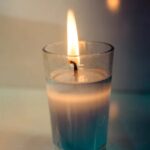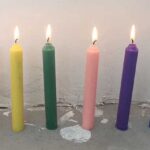Are you wondering how to measure wax for candle making? Whether you’re a beginner or an experienced candle maker, getting the right measurements is crucial for creating beautiful and long-lasting candles. In this article, we will delve into the importance of measuring wax accurately, the tools needed for the job, a step-by-step guide on how to measure wax, as well as some helpful tips and tricks.
Candle making is a popular and enjoyable hobby that allows you to create personalized and unique candles for yourself or as gifts for friends and family. From choosing the perfect fragrance to designing the ideal vessel, every aspect of candle making requires attention to detail – including measuring the wax accurately.
Accurate measurement of wax is crucial in achieving consistent results in your candle making endeavors. Without precise measurements, you may end up with uneven burning candles, reduced fragrance throw, or even safety hazards. As such, understanding how to measure wax properly is an essential skill for any candle maker.
Importance of Measuring Wax Accurately
When it comes to making candles, accurate measurements are crucial for achieving the perfect burn and scent throw. Accurately measuring wax is essential in ensuring that your candles turn out just right, whether you are a beginner or an experienced candle maker. Proper measurements will not only affect how well your candle burns, but also its appearance and longevity.
Ensuring Even Burning
Accurate wax measurements are vital for ensuring that the candle burns evenly. When the wax is poured into the container at the correct temperature and in the correct amount, it sets evenly, which means it will burn uniformly as well. This prevents tunneling, where the wax burns down the center leaving a thick outer rim of unmelted wax.
Achieving Desired Fragrance
Measuring wax accurately is also important for achieving the desired fragrance throw from your candles. Using too much or too little wax can affect how well the fragrance oil is dispersed throughout the candle. Too much fragrance oil in relation to the amount of wax can lead to an overpowering scent, while too little may result in a weak throw.
Ensuring Safety
Proper measurements are also important for safety reasons. Overfilling a container with wax can lead to spillover when the candle is lit, potentially causing a fire hazard. On the other hand, using too little wax may cause containers to become too hot during burning, increasing fire risk.
By measuring accurately, you can ensure that your candles are safe to burn. Learning how to measure wax for candle making is not only about creating beautiful and fragrant candles; it’s also about maintaining safety standards in your craft.
Tools Needed for Measuring Wax
When it comes to measuring wax for candle making, having the right tools is essential to ensure accuracy and success in creating your candles. Here are the essential tools you’ll need for measuring wax:
- Double boiler or melting pitcher: This is used to melt the wax evenly without direct heat, reducing the risk of scorching or burning.
- Measuring scale: A digital or analog scale will help you accurately measure the amount of wax required for your specific candle recipe.
- Thermometer: A candy or candle thermometer is used to monitor the temperature of the melted wax, ensuring that it doesn’t overheat and affect the quality of your candles.
- Pouring pitcher with a spout: This is essential for transferring the melted wax into candle molds or containers without making a mess.
Once you have these tools on hand, you’ll be ready to begin measuring your wax for candle making. It’s important to invest in high-quality tools to achieve consistent and professional results in your candle-making endeavors.
Remember, having the right tools not only ensures accuracy but can also make the process more efficient and enjoyable. By using the appropriate equipment, you’ll set yourself up for success when measuring wax for candle making.
Step-by-Step Guide on How to Measure Wax for Candle Making
When it comes to candle making, measuring wax accurately is crucial for achieving the desired results. Whether you are a beginner or an experienced candle maker, it’s important to follow a step-by-step guide to ensure that you measure the wax correctly. Here’s how to measure wax for candle making:
- Step 1: Choose the appropriate wax for your candles. Different types of wax have different melting points and densities, so it’s important to select the right one for your specific project.
- Step 2: Prepare your workspace by laying down a protective covering and gathering all the necessary tools, including a double boiler, thermometer, and digital scale.
- Step 3: Use a digital scale to measure the amount of wax needed for your candles. It’s important to refer to your specific candle recipe or instructions to determine the exact weight required.
Accurately measuring wax is essential for producing high-quality candles. Using too much or too little wax can result in uneven burning or poor fragrance throw. By following these steps on how to measure wax for candle making, you can ensure that your candles turn out just the way you want them.
- Tip: To prevent spills and make clean-up easier, consider using a disposable aluminum foil tray as a makeshift pouring pot when measuring and melting wax.
- Tip: Keep a record of your measurements and any adjustments made so that you can replicate successful batches in the future.
Avoiding common mistakes such as eyeballing measurements or using improper tools can help you achieve consistency in your candle making process. With practice and attention to detail, you can become proficient at measuring wax for candle making and create beautiful, high-quality candles every time.
Tips and Tricks for Measuring Wax Perfectly
Measuring wax accurately is crucial when it comes to making candles. It ensures that the candle burns properly and evenly, and also affects the fragrance throw. However, achieving the perfect measurement can be a bit challenging for beginners. Here are some tips and tricks to help you measure wax perfectly for your candle making endeavors.
Use a Digital Scale
One of the best tips for measuring wax for candle making is to invest in a good quality digital scale. This will give you the most accurate measurement of the wax needed for your candles. Digital scales are available at most kitchen supply stores or craft stores, and they typically have a tare function that allows you to measure the wax directly in your pouring pitcher or melting pot.
Use Volume Measurements as a Secondary Guide
While using a digital scale is the most accurate way to measure wax, having volume measurements as a secondary guide can be helpful as well. For example, if you know that a certain amount of wax fills half of your container, you can use this as a rough estimate in conjunction with weight measurements.
Avoid Overfilling or Underfilling
To ensure that you are measuring the right amount of wax for your candles, avoid overfilling or underfilling your pouring pitcher or melting pot. Always leave some room at the top to prevent spillage when melting and pouring, and ensure that you are using the appropriate size container for the amount of wax needed.
By following these tips and tricks on how to measure wax for candle making, you can achieve more consistent results in your candle-making process. Remember that practice makes perfect, so don’t get discouraged if it takes a few attempts to get your measurements just right.
Common Mistakes to Avoid When Measuring Wax
When it comes to candle making, measuring wax accurately is crucial for achieving the perfect candle. One of the most common mistakes that beginners make is not measuring the wax properly, which can lead to uneven burning and poor quality candles. In this section, we will discuss some common mistakes to avoid when measuring wax for candle making.
One of the most basic mistakes is using the wrong measuring tools. It’s important to use a scale specifically designed for candle making, as using regular kitchen scales can lead to inaccurate measurements. Additionally, using liquid measuring cups instead of a scale can also result in incorrect measurements, as wax should be measured by weight and not volume.
Another common mistake is not accounting for the type of wax being used. Different waxes have different densities, so it’s important to adjust your measurements accordingly. For example, soy wax has a lower density than paraffin wax, so you will need to measure a larger volume of soy wax to achieve the same weight as paraffin wax.
Lastly, failing to account for any additives or fragrance oils can also result in inaccurate measurements. It’s important to factor in these additional ingredients when measuring your wax to ensure that your candles turn out exactly as intended.
| Common Mistakes | Consequences |
|---|---|
| Using the wrong measuring tools | Inaccurate measurements |
| Not adjusting for different types of wax | Uneven burning and poor quality candles |
| Failing to account for additives or fragrance oils |
Adjusting Wax Measurements for Different Candle Sizes
When it comes to making candles, one size definitely does not fit all. Whether you’re making small tea lights or large pillar candles, the amount of wax you need will vary depending on the size of the candle you’re creating. This section will provide valuable insights into how to adjust wax measurements for different candle sizes, ensuring that your finished products turn out just the way you want them.
The key to adjusting wax measurements for different candle sizes lies in understanding the volume and dimensions of each individual candle. For smaller candles such as tea lights or votives, you’ll need less wax compared to larger container or pillar candles.
It’s important to carefully calculate the volume of wax needed based on the diameter and height of each specific candle mold or container. By doing so, you can avoid wasting excess wax or falling short on what’s needed to fill your molds properly.
One way to adjust wax measurements for different candle sizes is by utilizing a simple formula: Volume = πr²h. This formula takes into account the radius (r) and height (h) of your mold or container and allows you to calculate the exact amount of wax needed in fluid ounces or grams.
By taking precise measurements and using this formula, you can ensure that each type of candle you make receives the correct amount of wax, resulting in consistent quality across your entire product line.
Overall, adjusting wax measurements for different candle sizes requires a combination of careful calculations and attention to detail. By understanding the volume and dimensions of each type of candle you’re creating and using the appropriate formulas and tools, such as a kitchen scale or measuring cup, you can ensure that your candles turn out exactly as intended.
Whether you’re making tiny tea lights or towering pillar candles, getting the right amount of wax is crucial for a successful finished product. With these tips in mind, you’ll be well-equipped to measure wax accurately for any size candle.
Conclusion and Final Thoughts on Measuring Wax for Candle Making
In conclusion, learning how to measure wax for candle making is a crucial skill that can greatly impact the quality and outcome of your candles. Accurate measurements ensure that you achieve the right balance of wax and fragrance, resulting in a high-quality candle with optimal burn time and scent throw. By using the appropriate tools and following the step-by-step guide provided in this article, you can achieve consistent and professional results in your candle-making endeavors.
It is important to emphasize the significance of precision when measuring wax for candle making. Even slight variations in measurements can lead to uneven burning, poor fragrance distribution, or even safety hazards. Therefore, it is essential to invest in reliable scales, thermometers, and other measuring tools to ensure accuracy throughout the process. Additionally, utilizing tips and tricks such as double-checking measurements and choosing the right pouring temperature can further enhance the quality of your candles.
As you continue on your candle-making journey, remember to stay mindful of common mistakes to avoid when measuring wax. Overpouring or underpouring wax, incorrect temperature control, and neglecting to adjust measurements for different candle sizes are all potential pitfalls that can affect the final product.
By staying informed about these errors and taking proactive measures to prevent them, you can consistently produce exceptional candles that meet your expectations. With practice and attention to detail, mastering the art of measuring wax for candle making will undoubtedly contribute to your success as a candle maker.
Frequently Asked Questions
How Do You Measure Wax for a Candle Jar?
When measuring wax for a candle jar, you can use a kitchen scale to weigh the amount of wax needed. Simply place the empty jar on the scale and then pour the wax until you reach your desired weight.
What Is the Formula for Candle Wax?
The formula for candle wax varies depending on the type of wax being used. For example, if using soy wax, the formula might include soy wax flakes, fragrance oil, and dye (if desired). Each type of candle wax has its own specific formula to follow.
How Many Candles Does 1lb Wax Make?
The number of candles that 1lb of wax can make depends on the size of the candles being produced. On average, 1lb of wax can make approximately two 8oz candles or four 4oz candles. However, this can vary based on factors such as container size and desired candle thickness.

Welcome to my candle making blog! In this blog, I will be sharing my tips and tricks for making candles. I will also be sharing some of my favorite recipes.



